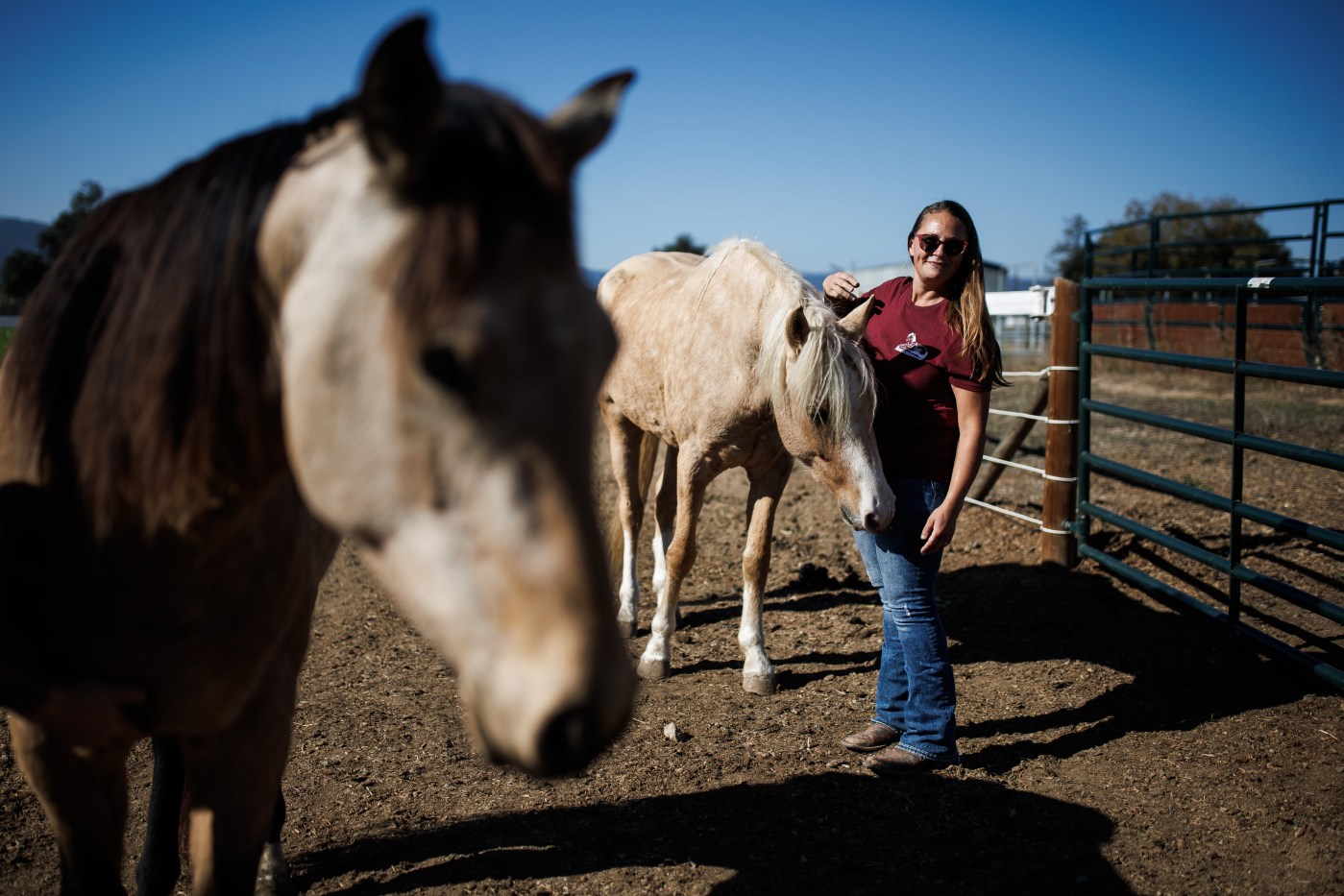Nestled between bucolic farmland and the rolling hills of the Diablo Range sits a nearly 10-acre piece of land that Dana De Frates and her husband Jason call their “little patch of heaven.”
The couple moved from Half Moon Bay to Gilroy eight years ago, purchasing a plot of land zoned for agricultural use in unincorporated Santa Clara County. The lifelong equestrian decided at the time to leave her staid corporate job behind to finally realize her dream of educating people on how to become better horse owners.
These days, people bring their equines from across the Bay Area to De Frates Horsemanship to learn new skills, get advice on caring for their animals or just to rekindle the sense of childlike wonder they once experienced with a new horse.
Owners Jason and Dana De Frates talk during an interview at De Frates Horsemanship, an equestrian business they operate in Gilroy, Calif., on Oct. 20, 2025. (Dai Sugano/Bay Area News Group)
But anxiety and confusion are growing among owners of equine businesses in southern Santa Clara County as officials re-examine the type of development and operations allowed in rural and agricultural zoning districts in unincorporated areas. Particularly alarming for many is a draft proposal of changes to the rural zoning codes that appear to no longer classify horses as livestock or permit stables in the “ag exclusive” zone.
“My first reaction was panic,” said De Frates, whose business is located in that area.
Leza Mikhail, the deputy director of the county’s department of planning and development, declined an interview but said in an email response to written questions that the “county is not proposing to rezone any properties.”
“The overall purpose of the amendments is to standardize, clarify, and streamline existing regulations, support agricultural viability and land, and protect the rural character of Santa Clara County,” she said.
Businesses currently operating with the required permits in the existing code will be allowed to continue operating, and the county is considering an “amnesty program” for businesses that need to come into compliance, according to Mikhail.
But even though De Frates has followed all the rules and regulations, she still worries about what her future holds as county officials have said that any “new or expanded uses” of properties would have to follow the amended zoning codes.
That could impact De Frates’ hopes of providing breeding services, taking in retired horses and creating a facility where people can come from around the world to learn about her training methods.
“I’m disappointed that those opportunities would be taken away from me, and that’s just to me a little bit of a letdown for our government to limit me,” De Frates said. “I want to do good things, I want to help people, I want to make people smile and I want to bring joy to their lives and help them form incredible bonds with their horses.”
Owner Dana De Frates tends to two miniature horses at De Frates Horsemanship, an equestrian business she and her husband operate in Gilroy, Calif., on Oct. 20, 2025. (Dai Sugano/Bay Area News Group)
Tyler Flippo, the owner of Coyote Canyon Ranch in Morgan Hill, fears the new changes could force him to lose his business altogether. He boards about 50 to 60 horses at any given time and farms 200 acres in the Coyote Valley area, including hay for a separate business he operates.
Flippo tried to get a permit a decade ago when he first opened his business, but he couldn’t afford the cost, which he estimates was around $10,000 at the time. Since hay has small profit margins, he said his horse boarding business helps sustain his hay business. If he can’t afford to come into compliance before the zoning codes are amended, he said it will likely “wipe me out completely.”
He said many others are in similar positions across southern Santa Clara County — operating without permits due to the steep fees.
“We’re stuck in this weird in-between where we want to be legal, we don’t want to be breaking the law,” Flippo said. “But they’ve made it impossible for us and there’s no out and now they’ve got us up against the wall.”
Over the last month, the county has held a series of meetings to gather feedback on the proposal. Martha McNiel, the director of the nonprofit DreamPower Horsemanship, has attended several of the meetings and thinks there’s a lot of confusion on the issue.
“There’s a lot of unintended consequences that I don’t think they foresaw or expected,” she said of county officials.
McNiel, who is a licensed marriage and family therapist, has worked for more than two decades providing equine-assisted therapy to individuals who haven’t succeeded in a more traditional office-based therapy.
She rents the facility that the nonprofit operates out of in Gilroy and worries because she doesn’t know whether it’s in compliance with current codes or not. The profit margins of operating many equine businesses are low, and upgrading to be in compliance with the current code is “cost prohibitive,” according to McNiel. She fears that a lot of these businesses might move to an area that has an easier regulatory environment, leaving many of their clients in the lurch.
“We came here because of the equestrian community and I think many people here did the same thing,” McNiel said. “They came here because of the rural nature of it and if all of this were to shut down and we were to become another bedroom community of commuters, I think it would be losing the charm and the attractiveness of the South County area.”
The county’s Mikhail said in an email that the county “is taking a closer look at how to balance the needs of the equestrian community,” and that “hearing from these communities will help the county determine a path forward.”
Many equine businesses ultimately agree with the county’s intent of preserving agricultural lands, but fear the unforeseen consequences that could put their livelihoods — and community — at risk.
“Let’s make sure ag land stays ag,” Jason De Frates said. “I don’t want to look over there and see condos or townhouses. However, by doing some of these things they’re pushing out these small farmers and equestrian facilities that are at the core of a lot of agriculture. It really just limits of uses that we have in the area.”
One of the 15 horses at De Frates Horsemanship waves its tail on the property in Gilroy, Calif., on Oct. 20, 2025. (Dai Sugano/Bay Area News Group)





